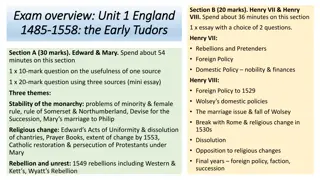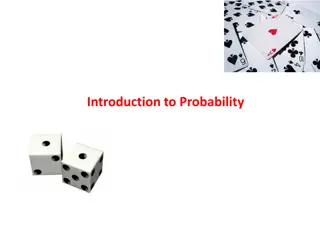Understanding Statistics and Probability in Class VIII
Learning about statistics and probability in Class VIII involves collecting, organizing, and interpreting numerical data. Topics include measures of central tendency, arranging data into graphs like histograms and pie charts, and understanding frequency distribution tables. The content covers grouped frequency distribution, graphical methods of representing data like bar graphs and histograms, and the importance of presenting data effectively.
Download Presentation

Please find below an Image/Link to download the presentation.
The content on the website is provided AS IS for your information and personal use only. It may not be sold, licensed, or shared on other websites without obtaining consent from the author. Download presentation by click this link. If you encounter any issues during the download, it is possible that the publisher has removed the file from their server.
E N D
Presentation Transcript
. STATISTICS AND PROBABILITY CLASS VIII
In previous classes we have learnt about data collection, organising a given data, reading and preparing bar graphs. We have also learnt about the measures of central tendency Mean, Median and Mode. Now, we shall learn to arrange a given data into graphs and display the data as histogram, pie chart and probability. STATISTICS Statistics is science of collecting classifying, summarizing, analysing and interpreting numerical facts. OBSERVATIONS Information in the form of numerical figures is called observations. RAW DATA Collection of all observations is called data or raw data.
PRESENTATION OF DATA Arranging the data in ascending or descending order is called presentation of data or organizing the data. RANGE The difference between the highest and the lowest values of the observations is called the range of the data. Range = Highest observation Lowest observation FREQUENCY The number of times a particular observation occurs in a data is called its frequency. FREQUENCY DISTIBUTION TABLE A table which shows the frequencies of various observations of a data is called frequency distribution table.
GROUPED FREQUENCY DISTIBUTION In case of very large data, the raw data is divided into suitable number of groups (class intervals) to obtain a frequency distribution of the number of observations falling in each class interval. A table showing the frequencies of various class intervals is called a frequency distribution table and the data in this form is called a grouped frequency data. If the class interval is 10 -20 then in this class 10 is the lower limit and 20 is the upper limit. CLASS SIZE OR CLASS WIDTH The difference between the upper limit and the lower limit is called class size or class width. Class Size = Upper Limit Lower Limit CLASS MARK The average of upper and lower limits is called class mark. Class Mark = ????? ????? + ????? ????? ?
GRAPHICAL METHOD OF REPRESENTING DATA BAR GRAPH A bar graph is a pictorial representation of the numerical data by a number of rectangles (bars) of uniform width erected vertically from the same base line with equal spacing between them. HISTOGRAM A histogram is a graphical representation of a frequency distribution in the form of rectangles with class intervals as bases (equal) and heights proportional to corresponding frequencies such that there is no gap between any two successive rectangles (bars).
WORKSHEET 1 Q1. Soln: AGE (IN YEARS) TALLY MARK NUMBER OF STUDENTS 12 IIII 5 13 IIII IIII 9 14 IIII IIII II 12 15 IIII 4 TOTAL 30
Q3. Soln: WAGES (IN `) TALLY MARK NUMBER OF STUDENTS 150 III 3 200 IIII 5 250 IIII 4 300 II 2 350 I 1 TOTAL 15
(i) Range of wages = Highest wage Lowest wage = ` (350 150) = `200 (ii) 2 workers are getting `300. (iii) 1 workers is getting the maximum wage i.e. `350. Q4.
MIN. TEMPERATURE (IN C) TALLY MARK NUMBER OF Soln: DAYS 24.0 25.5 II 2 25.5 27.0 IIII IIII III 13 27.0 28.5 IIII IIII 9 28.5 30.0 III 3 30.0 31.5 III 3 TOTAL 30 Corresponding to Maximum Frequency (i.e 13) (i) Class Interval : 25.5 27.0 (ii) Class Size = Upper Limit Lower Limit = 27.0 25.5 = 1.5 C (iii) Class Mark = Upper Limit + Lower Limit 2 = 25.5 + 27.0 2 = 26.25
Video Link https://www.youtube.com/watch?v=iXDtIz0maeg
Q5. (i) What information is depicted by the above histogram? Ans: The histogram shows the number of literate females in different age groups.
(ii) In which age group is the number of literate females maximum? Ans: The number of literate female are maximum in the age group 25 30 years. (iii) In which age group is the number of literate females minimum? Ans: The number of literate female are minimum in the age group 45 55 years. (iv) How many females below 35 years of age are literate? Ans: Number of females below 35 years of age are literate = 300 + 900 + 1000 + 400 + 250 = 2850 females Q8.
Soln: ELECTRICITY BILLS(IN ` ) TALLY MARK NUMBER OF HOUSES 300 400 IIII 5 400 500 III 3 500 - 600 IIII I 6 600 - 700 IIII 4 700 - 800 IIII II 7 TOTAL 25
CIRCLE GRAPH OR PIE CHART A pie chart consists of a circle divided into as many sectors as there are classes in a frequency distribution. The size of the sector is proportional to the frequency of the class represented by the sector. WORKSHEET-2 Find the fraction of the circle representing each of the information given below: (i) S.NO. PROGRAMME % OF VIEWERS FRACTION OF CIRCLE 60 100 = 3 20 100 = 1 10 100 = 1 10 100 = 1 1 ENTERTAINMENT 60% 5 2 SPORTS 20% 5 3 NEWS 10% 10 4 INFORMATION 10% 10 TOTAL :100%
(iii) S.NO. DESSERTS SECTORS FRACTION OF CIRCLE 144 360 = 2 18 360 = 1 36 360 = 1 1 CAKES 144 5 2 DOUGHNUTS 18 20 3 MUFFINS 36 10 4 COOKIES 54 54 360 = 3 108 360 = 3 20 5 PASTRIES 108 10 TOTAL :360
VALUE BASED QUESTION a) Prepare a frequency distribution and draw a histogram for the above data WEIGHTS TALLY MARK NUMBER OF STUDENTS 35 45 IIII 4 45 55 IIII IIII I 11 55 - 65 IIII IIII III 13 65 - 75 II 2 TOTAL 30
b) In what weight range do most students lie? Ans: Most students lie in the weight range of 55 65 kg. c) How many students got selected for the training? Ans: 11 students are selected for the training. d) What percentage of students weigh more than 55 kg? Ans: Number of students having weight more than 55kg = 13 + 2 = 15 Percentage of students weighing more than 55 kg = 15 30 x 100 = 50%
e) What factors are responsible for so many children being overweight and obese these days? Ans: Lack of exercise and consumption of junk food are responsible for children being overweight. f) How can healthy eating habits be developed amongst the students of this age group? Ans: By spreading awareness of advantages of healthy living. BRAIN TEASERS Q1 B (b) Soln: Range = Maximum Height Minimum Height = (128 72) cm = 56 cm
Q2. i) What information is depicted by the above histogram? Ans: The histogram depicts the salary obtained by workers. ii) Prepare a grouped frequency table for the histogram. Ans: SALARY (`) NUMBER OF WORKERS 2000 2500 50 2500 3000 40 3000 3500 80 3500 4000 60 4000 4500 20 4500 5000 10 TOTAL 260 iii) Find the number of workers having salaries more than `3500. Ans: Number of workers having salaries more than `3500 = 60 + 20 + 10 = 90 (iv) In which group is the number of workers maximum? Ans: The number of workers are maximum in the group 3000 3500.
(v) In which group is the number of workers minimum? Ans: The number of workers are minimum in the group 4500 5000. (vi) What are the class marks of all the class intervals? Ans: Class mark of interval 2000 2500 = UPPER LIMIT + LOWER LIMIT = 2000 + 2500 Class mark of interval 2500 3000 =2500 +3000 Similarly, 2 = 2250 2 = 2750 2 Class mark of interval 3000 3500 = 3250 Class mark of interval 3500 4000 = 3750 Class mark of interval 4000 4500 = 4250 Class mark of interval 4500 5000 = 4750
Q3. WATER BILL (IN `) Soln: TALLY MARK NUMBER OF HOUSES 0 15 II 2 15 30 II 2 30 45 IIII II 7 45 60 II 2 60 75 IIII 4 75 90 IIII I 6 90 105 III 3 105 120 IIII 4 TOTAL 30
HOMEWORK WORKSHEET -1 Q2, Q6, Q7, Q9, Q10 WORKSHEET 2 (ii), (iv) BRAIN TEASERS Q4























